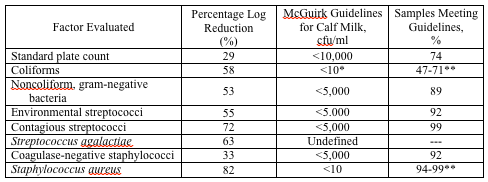
 Controlling costs without compromising quality challenges every producer throughout their operation. Switching to feeding non-saleable milk to heifers can reduce expenses; however challenges exist. Potentially the milk harbors harmful pathogens which can reduce growth rates or contribute to scours.
Controlling costs without compromising quality challenges every producer throughout their operation. Switching to feeding non-saleable milk to heifers can reduce expenses; however challenges exist. Potentially the milk harbors harmful pathogens which can reduce growth rates or contribute to scours. Research has shown that calves fed pasteurized waste milk are 8 pounds heavier at weaning and have less severe cases of scours than those fed unpasteurized, non-saleable milk. More recently ultraviolet (UV) light has been considered as a way to reduce pathogen load. For example, the Food and Drug Administration (FDA) approved the use of UV light to inactivate bacteria in fruit juice.
Recently some UV systems have made their way onto farms to inactivate bacteria in nonsaleable milk. The systems are totally automated with milk cycling from a holding tank through the UV light system and back into the holding tank multiple times. As the system ages, the number of cycles increases to maintain the desired dose of UV light.
The total number of organisms present, the dose of UV light, and the solids concentration have all been shown to influence how well the system works on juice. Recently Penn State researchers evaluated the effectiveness of UV light treatment on nine farms that had installed the system during the previous four years in Pennsylvania. Samples of non-saleable milk were collected twice daily both before and after UV treatment for fifteen days. All samples were frozen on the farm and then taken to Penn State University for analysis for eight factors listed in Table 1.
In addition, the total solids percentage was estimated so the impact of solids concentration on UV light inactivation of bacteria in waste milk could be evaluated. As the total solids percentage increased, UV treatment was less effective in reducing environmental streptococci and coagulase-negative staphylococci and tended to be less effective in reducing standard plate count. The milk solids averaged 10.4% and ranged from 8.3 to 13.9%.
Table 1 shows the percentage log reduction for each of the eight factors evaluated. Before UV light treatment 43% of the samples met the Grade A Pasteurized Milk Ordinance requirement for both a standard plate count of less than 100,000 cfu/ml and a coliform count of less than 100 cfu/ml. After UV treatment 47% of the samples met the FDA requirement of a standard plate count of less than 20,000 cfu/ml and a coliform count of less than 10 cfu/ml for pasteurization.
McGuirk has developed recommended guidelines for maximal bacterial contamination in milk used for rearing calves. These are listed in Table 1. After treatment with UV light, 43% of all samples collected in the Penn State study met every requirement. The percent of samples meeting each individual guideline are shown in Table 1.

To date there have not been studies comparing the performance of calves fed milk treated with UV light, pasteurized, and non-pasteurized. From this study it is apparent that UV light can be a successful tool to inactivate bacterial contamination in non-saleable milk. However the effectiveness varies with the type of bacteria present in the non-saleable milk.
Besides effectiveness, dairy producers must consider the initial investment in equipment and maintenance costs for UV light compared to either batch or high-temperature, short time pasteurization. Also, they need to calculate other costs of operation such as energy and the capacity of the system. Weigh options carefully, the final decision comes down to effectiveness, initial cost, longevity, operating costs, and personal preference.
5.1.2014